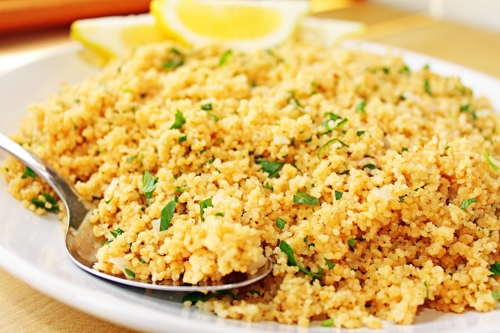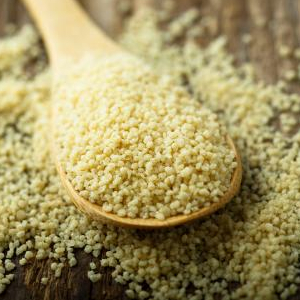At least one young generation has made Ramen the darling dish of its lunches, suppers and snacks. Some of the under-30s who’ve jumped on the instant noodle bandwagon have even embraced it as a breakfast staple… But now, there’s something new…
 Beautiful Golden Lemon Couscous: With
Beautiful Golden Lemon Couscous: With
classic accompaniment of Green Peas.
If you go to Northwesterrn Africa or explore the southern coast of the Mediterranean, you’ll find there’s a third major ‘starch’ that millions in that part of the world know and love. And take for granted like the Italians do pasta and Asians do rice…
Animal, vegetable or mineral?
That used to be the first question folks would ask when served it for the first time. Actually, it’s a micro-mini pasta originally from what is now called Morocco, probably invented by the Berber tribes people first known to have continuously populated the desert paradise.
If you haven’t got it by now, it’s couscous! Often filling a slot on your plate that potatoes or pasta would in Northeast Europe, pasta or rice would in southern Europe and Rice alone would in much of Asia, the stuff is ubiquitous in places such as Morocco, Algeria, Tunisia, Lybia, and parts of the middle east. It’s traditionally made from wheat semolina via a unique process that involves cooking the semolina until creamy smooth, then rubbing it into very fine particles of pasta that absorb water almost instantly and, like other pastas, will expand to two or three times their dry size as they cook. Given how small they start out dry, that’s not saying a lot – until you see them in their hundreds of thousands in your cooking pot for the first time.
Perfect couscous
Couscous is similar to Ramen and some ‘instant’ pastas in as much as it requires next to no cooking time. But it benefits from standing and steaming for 10-15 additional minutes before being given a final fluff with a fork and gently served onto a plate or into a shallow bowl.
If you have a microwave oven (and who doesn’t, these days?) you really don’t even need a pot. I just measure out one part dry couscous and two parts water or stock in two separate measuring cups, then microwave the liquid for 1:30 min, per cup liquid. I then add the liquid to a large pyrex mixing bowl (allowing for expansion while the couscous cooks). I usually use a 2-quart bowl for my standard batch, which consists of one cup of dry pasta plus 2 cups of boiling liquid. Give the mixture a quick stir and place covered back in the microwave for another 30 sec. When the ‘done’ signal goes off, just leave the bowl in the mic without disturbing it, for at least another 10 minutes (up to 15, if you like fluffier, more ‘fully-bloomed’) couscous. Then uncover, fluff and serve while the pasta is still steaming hot.
There are other tips and hacks galore for ‘cooking couscous perfectly’. Here’s a really good, collective reference…
Unlike other (mainly Italian) pasta, Couscous was made to be flavoured. So experiment with cooking it in liquids other than plain water. One classic favourite is lemon which uses water infused with as much lemon juice and rind as you like. Meat and veggie broths are also really good choices for couscous that will complement perfectly the meat or veggie dishes you intend to serve.
Serve with?
Top with savoury stews or concoctions from the equally amazing Mediterranean Tajine simmering/braising dish. Just mixing in some harissa condiment makes couscous an exotic side for any spicy or umamiful main.
You can also mix some couscous into soups to give them body, the way you’d toss a handfull of tiny pasta shells into Italian Wedding soup. Don’t cook the couscous before adding to soup. You don’t want it to go completely mushy, or just end up thickening up the dish like a flour or cornstarch slurry would.
Equally good served chilled
Couscous is also a favourite in cold dishes, particularly chopped salads. You can sub-in couscous anywhere you’d use cold rice or mini pastas. I just used cold, leftover couscous in a burrito, in the same role and technique I’d use rice.
And what did we hint at earlier? Couscous for breakfast? Try it hot and cold, topped with milk and stuff you’d normally put on cereal…
Can you save leftover couscous?
Which brings me to a good question: Can you safely save and re-heat couscous? The answer is a conditional ‘yes’. Be sure you close up leftover couscous tightly with minimal air space in he container and store on the bottom shelf of the fridge for up to 2 days. Don’t let it sit out on the counter or (worse) in the cooking pot any longer than you have to. Couscous is as notorious as leftover rice for harbouring food-borne germs and other food poisoning agents – when not handled intelligently with ample reverent reference to the FAT TOM rule.
So what are you waiting for?
Couscous is quick, easy, versatile and tasty. Not to mention almost impossible to ruin during cooking. If your previous cooking experience is limited, it’s a safe place to go when first stepping outside your limited stoveside comfort zone.
~ Maggie J.

